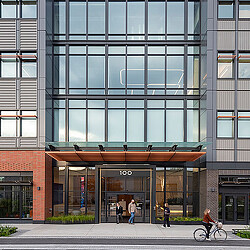The Carbon Impact of a Workday
When people calculate their carbon impact, they typically consider their cars, food, clothes, and flights. But they rarely consider where they spend their day. It’s time to change that.

When a global pandemic sent office workers home in droves, we were forced to rethink every aspect of our lives, and in the search for silver linings, one quickly emerged: Maybe all this working from home was actually good for the planet. After all, our office buildings were practically empty — heat and AC were turned down, lights were turned off, and most of our computers came home with us. And of course, we weren’t commuting — a factor that immediately cut our collective carbon impact (and in some cities, visibly reduced pollution). The biggest consequences were attached to those who drove gas-powered cars; lesser impacts came from those who drove electric vehicles, and even less for those taking public transit, not to mention those who bike or walk to work.
These factors conspired to lower our carbon impact. But was working from home the perfect solution that many made it out to be? Not quite.
When the Gensler Research Institute joined forces with the brilliant folks at the MIT Mobility Initiative to explore that question, things got complicated. For instance, the collective square footage of our homes far exceeds that of our offices. And the conditioning of all those residential spaces emits a lot of carbon. Were we saving carbon emissions, or just shifting where they came from? That’s one of the many questions we’ve asked — and answered — in our joint report: The Carbon Impact of a Workday.
Smaller Areas, Bigger Impacts
Nearly all knowledge workers occupy less square footage when working from the office versus working at home — 150 square feet per person for most fully occupied offices vs. 650 per person in the typical apartment complex and 1,000 per person in the typical single-family home. If you have access to office space, it’s likely being conditioned (heated or cooled) during every workday, whether you’re there or not.
Clearly, conditioning our homes tends to emit far more, per person, than conditioning our offices — and that gap is often larger than the carbon impact of our commutes.
As we looked to quantify the full carbon impact of office work, it became clear that decisions regarding how and where we work have significant implications. But first, some foundational truths that quickly revealed lessons for anyone looking to reduce their carbon impact:
- Your location makes a big difference: In cities with cleaner energy grids (e.g., New York) and/or milder climates (e.g., Los Angeles), heating and cooling your space is less carbon-intensive overall, so the commute becomes a more significant factor in the equation. In New York, where public transit dominates, the commute has a minor impact; in L.A., where long commutes in gas-powered cars are common, working in more dense spaces is still beneficial — we just need a more distinct focus on sustainable methods of transit.
- New buildings are much more efficient than older buildings. This seems obvious, but it’s heartening to see how much progress we’ve made: A building designed and constructed to today’s code is heated or cooled with significantly less energy than one built 20+ years ago. And this applies to our homes, our offices, and all the spaces in our cities. That’s why it’s so important to renovate buildings to meet new energy standards, and why many cities are implementing incentives and penalties to ensure that more buildings meet minimum performance requirements.
- We need to minimize the carbon impact of our commutes — and indeed, all of our travel — an area where cities have a huge role to play. The move to electric cars is lowering our collective carbon impact, but transit is far superior, per commuter, which means cities should invest in public transportation, and employers should locate their offices in the most accessible areas.

What Corporate Leaders Can Do
Many companies have already brought their employees back to the office, a positive trend in light of this research, and one that Gensler obviously supports as a champion of vibrant, connected office spaces. Still, not every company or employee will return to the office five days a week, given the dozens of factors shaping this decision at the individual and organization level. But regardless of your views on return-to-office mandates, there are a few conclusions we can all agree on:
- The more people gather in shared spaces, the lower the carbon impact of each person; this goes for offices, but it also goes for public parks, public transit, and programs like universal pre-K or eldercare. Of course, the benefits of being together go far beyond carbon impacts — pre-K and eldercare also free up more time for working-age adults, for example.
- When we’re not in our homes, we should rein in our thermostats or turn our HVAC systems off entirely. When we are home, we should limit our heating and air conditioning to the rooms where we spend the most time. Smart thermostats make these actions much easier than they were even 10 years ago.
- Our modes of transportation make a big difference: Long commutes in gas-powered cars emit a lot of carbon — but that shouldn’t be an excuse to avoid movement; it should be a nudge to find less carbon-intensive ways of moving.
To move the needle, we’ll need action at the scale of organizations, communities, and cities. If you make decisions that affect dozens, hundreds, or thousands of employees, you have an incredible impact on the environment. As you determine where your employees work and how they get there, keep carbon in mind.

For media inquiries, email .







